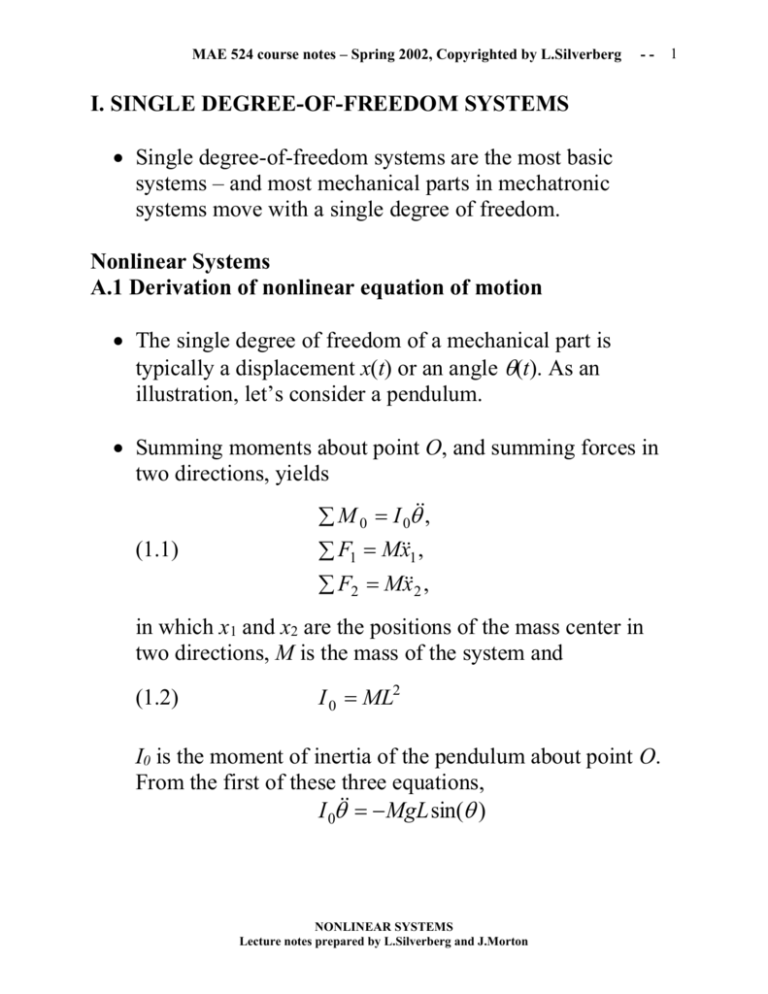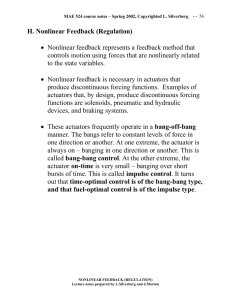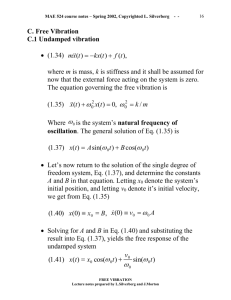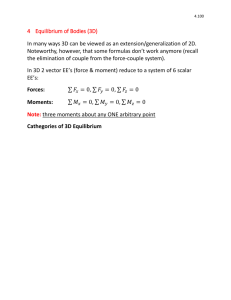II Single Degree of Freedom ( 1DOF ) Systems
advertisement

MAE 524 course notes – Spring 2002, Copyrighted by L.Silverberg
--
I. SINGLE DEGREE-OF-FREEDOM SYSTEMS
Single degree-of-freedom systems are the most basic
systems – and most mechanical parts in mechatronic
systems move with a single degree of freedom.
Nonlinear Systems
A.1 Derivation of nonlinear equation of motion
The single degree of freedom of a mechanical part is
typically a displacement x(t) or an angle (t). As an
illustration, let’s consider a pendulum.
Summing moments about point O, and summing forces in
two directions, yields
(1.1)
M 0 I 0,
F1 Mx1 ,
F2 Mx2 ,
in which x1 and x2 are the positions of the mass center in
two directions, M is the mass of the system and
(1.2)
I 0 ML2
I0 is the moment of inertia of the pendulum about point O.
From the first of these three equations,
I 0 MgL sin( )
NONLINEAR SYSTEMS
Lecture notes prepared by L.Silverberg and J.Morton
1
MAE 524 course notes – Spring 2002, Copyrighted by L.Silverberg
--
2
Dividing by I0 yields the nonlinear differential
equation governing the rotational motion of the
pendulum.
g
(1.3)
sin( )
L
A.2 Equilibrium positions
There exist points at which mechanical parts can be
positioned and remain there at rest. These rest
positions are called equilibrium positions. The
equilibrium positions are found by substituting
0
into the nonlinear differential equation, and by solving
the resulting nonlinear algebraic equation. In the
case of the pendulum, we get
g
f ( ) sin( ) 0
L
which yields the two equilibrium positions
0(1) 0, 0( 2) .
The first equilibrium position is stable while the
second equilibrium position is unstable.
NONLINEAR SYSTEMS
Lecture notes prepared by L.Silverberg and J.Morton
MAE 524 course notes – Spring 2002, Copyrighted by L.Silverberg
--
3
A.3 Linearization in the configuration space
We can understand how a system moves in the
neighborhood of an equilibrium position by
linearizing the nonlinear differential equation of
motion about the equilibrium position and by solving
the resulting equation.
(1.4)
g
L
f ( ), f ( ) sin( ).
Next, expand f() in a Taylor series about 0 and retain
the first two terms (the linear terms).
f ( ) f ( 0 ) (
f
f
)0 ( 0 ) ( )0 ( 0 )
Notice that f(0) = 0 (Why?). Next, redefine the angle
using the equilibrium position as a reference. We let
(1.5)
0.
Substituting Eq. (1.5) into Eq. (1.4) for the first
equilibrium position, yields
(1.6)
g
L
and substituting Eq. (1.5) into Eq. (1.4) for the second
equilibrium position, yields
NONLINEAR SYSTEMS
Lecture notes prepared by L.Silverberg and J.Morton
MAE 524 course notes – Spring 2002, Copyrighted by L.Silverberg
--
4
g
L
(1.7)
(1.8)
A cos(t ) B sin(t )
where A and B are constants that depend on the initial
conditions. Looking at Eq. (1.8), notice that the
response in the neighborhood of the first equilibrium
position is harmonic, regardless of the constants A and
B. Thus, the first equilibrium position is stable, as
expected.
Now turning to the second equilibrium position, let’s
solve Eq. (1.7). The general solution to Eq. (1.7) is of
the form
(1.9)
Aet Bet
where A and B depend on the initial conditions. This
time, notice that the solution is an unbounded function
of time, regardless of the constants A and B (unless A
= 0*). Thus, the second equilibrium position is
unstable, as expected.
NONLINEAR SYSTEMS
Lecture notes prepared by L.Silverberg and J.Morton
MAE 524 course notes – Spring 2002, Copyrighted by L.Silverberg
--
5
A.4 The state space
The single degree-of-freedom of the pendulum was
associated with the pendulum’s configuration. For this
reason, the linearization described in the previous
section is referred to as being carried out in the
configuration space. In contrast, the state space uses
variables that describe the system’s state. The
pendulum’s state is comprised of the angle (t) and its
angular rate (t ).
From Eq. (1.4), the two state equations that describe
the system are
(1.10)
x1 (t ) (t ), x2 (t ) (t )
(1.11)
g
x1 x2 , x 2 sin( x1 )
L
Equations (1.11) are two first-order differential
equations. The first of the two equations specifies
what we mean by x2(t) and the second of the two
equations is the equation of motion coming from Eq.
(1.4). So, one second-order differential equation has
been converted into two first-order differential
equations.
Let’s now retrace our steps and re-develop the
material covered in sections A.2 and A.3 using this
state-variable format.
NONLINEAR SYSTEMS
Lecture notes prepared by L.Silverberg and J.Morton
MAE 524 course notes – Spring 2002, Copyrighted by L.Silverberg
--
Equilibrium state
Let’s first rewrite the state equations (1.11) in the
general functional form
(1.12)
x1 (t ) f1 ( x1 , x2 , t ), x 2 (t ) f 2 ( x1 , x2 , t )
In terms of the state variables, the equilibrium state is
found by substituting
x1 0 and x2 0
into Eq. (1.12) to get
(1.13)
0 f1 ( x1( r ) , x2( r ) , t ), 0 f 2 ( x1( r ) , x2( r ) , t ),
where x1( r ) and x2(r) denote the r-th equilibrium state (r
= 1, 2). In the case of the pendulum, the two
equilibrium states are
x1(1) 0, x2(1) 0, and
x1(2) , x (2)
2 0.
NONLINEAR SYSTEMS
Lecture notes prepared by L.Silverberg and J.Morton
6
MAE 524 course notes – Spring 2002, Copyrighted by L.Silverberg
--
Linearization in the state space
Next, let’s linearize the state equations (1.12) about
each of the equilibrium states.
f
f
f1 ( x1 , x2 , t ) ( 1 ) 0 ( x1 x1( r ) ) ( 1 ) 0 ( x2 x2( r ) ),
x1
x2
f 2
f
) 0 ( x1 x1( r ) ) ( 2 ) 0 ( x2 x2( r ) ).
x1
x2
We define the new state variables
f 2 ( x1 , x2 , t ) (
y1 (t ) x1 (t ) x1( r ) , y2 (t ) x2 (t ) x2( r ) .
Now, substitute the Taylor series approximations into
Eq. (1.12).
(1.14)
y1 (t ) y 2 (t ), y 2 (t )
g
y1 (t ).
L
Equations (1.14) describe the pendulum’s state in the
neighborhood of the first equilibrium state. Next,
evaluate the appropriate partial derivatives at the
second equilibrium state and obtain the linearized
equations about the second equilibrium state,
g
y1 (t ).
L
Equations (1.15) describe the pendulum’s state in the
neighborhood of the second equilibrium state.
(1.15)
y1 (t ) y2 (t ), y 2 (t )
NONLINEAR SYSTEMS
Lecture notes prepared by L.Silverberg and J.Morton
7
MAE 524 course notes – Spring 2002, Copyrighted by L.Silverberg
--
8
A.5 Stability in the state space
Let’s now solve Eqs. (1.14) and (1.15) and determine
the stability characteristics of each of the pendulum’s
equilibrium states (although we all ready know the
answer to this). Try a solution to Eq. (1.14) in the form
y1 1e st , y2 2 e st .
(1.16)
Substitute Eq. (1.16) into Eq. (1.14), and divide by est,
to get
g
s1 2 and s2 1
L
g
0,
L
from which we find that
s2
s i .
The general solution in the neighborhood of the first
equilibrium state is
y1 (t ) A1e it A2 e it
A1 (cos(t ) i sin(t )) A2 (cos(t ) i sin(t ))
A cos(t ) B sin(t )
NONLINEAR SYSTEMS
Lecture notes prepared by L.Silverberg and J.Morton
MAE 524 course notes – Spring 2002, Copyrighted by L.Silverberg
--
9
This is a harmonic response, and hence stable. Turning
to the second equilibrium state, substituting Eq. (1.16)
into Eq. (1.15) and dividing by est, yields
s2
g
0,
L
so
s .
The general solution in the neighborhood of the
second equilibrium state is
y1 Aet Bet
which is an unbounded response, and hence unstable.
NONLINEAR SYSTEMS
Lecture notes prepared by L.Silverberg and J.Morton
MAE 524 course notes – Spring 2002, Copyrighted by L.Silverberg
- - 10
A.6 Vector methods
The following reviews the equations that were
developed in section A.5, now expressing all of the
quantities in vector-matrix form. Begin by defining the
state vector as:
x (t )
x(t ) 1
x 2 (t )
The nonlinear state equations (1.12) are written as
(1.17)
x (t ) f (x, t )
and the equilibrium equation is
0 f (x 0 , t )
(1.18)
0 f (x (0r ) , t ).
The Taylor series expansion of f, in matrix-vector
form, is
f (x, t ) (
where
f T
) 0 (x x 0 ),
x
f1
f x1
x f1
x2
f 2
x1
.
f 2
x2
NONLINEAR SYSTEMS
Lecture notes prepared by L.Silverberg and J.Morton
MAE 524 course notes – Spring 2002, Copyrighted by L.Silverberg
- - 11
The new state vector is
(1.19)
y x x0 .
Substituting Eq. (1.19), and the Taylor series
approximation of f into Eq. (1.17), yields the
linearized state equations:
f T
) .
x 0
The solution to Eq. (1.20) is found by trying a solution
in the form
(1.20)
(1.21)
y Ay, A (
φ1
y φe , φ .
φ2
t
Substituting Eq. (1.21) into Eq. (1.20) yields
(1.22)
φ Aφ.
Equation (1.22) is called the eigenvalue problem, φ
are called eignevectors, and are called eigenvalues.
The eigenvalue problem can be rewritten as
[λ I A] φ 0,
NONLINEAR SYSTEMS
Lecture notes prepared by L.Silverberg and J.Morton
MAE 524 course notes – Spring 2002, Copyrighted by L.Silverberg
- - 12
where I denotes the 2 x 2 identity matrix. The inverse
of the matrix in brackets does not exist if its
determinant is zero, that is if
(1.23)
det[λ I A] 0.
Equation (1.23) is called the characteristic equation
of the matrix A. Once the characteristic equation is
solved, the eigenvalues are substituted back into Eq.
(1.22) and the eigenvectors are determined.
The general solution is
(1.24)
y (t ) φ1 A1e1t φ2 A2e2t .
Equation (1.24) solves Eq. (1.20) and A1 and A2 are
complex coefficients that depend on the initial
conditions. We see in Eq. (1.24) that the linearized
system is stable if Re{r } 0, r 1, 2. Otherwise,
the system is unstable.
NONLINEAR SYSTEMS
Lecture notes prepared by L.Silverberg and J.Morton









